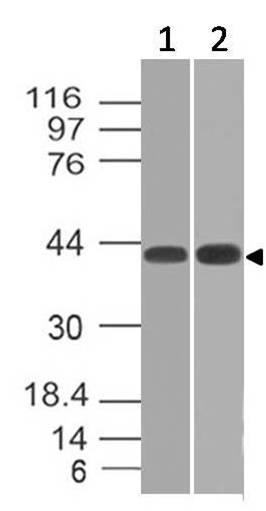Recombinant Human P2RX7 Protein, hFc Tag
Shipping Info:
For estimated delivery dates, please contact us at [email protected]
| Amount : | 50 µg |
| Content : | Lyophilized from sterile PBS, pH 7.4. Normally 5 % - 8% trehalose is added as protectants before lyophilization. |
| Storage condition : | Store at -20°C to -80°C for 12 months in lyophilized form. After reconstitution, if not intended for use within a month, aliquot and store at -80°C (Avoid repeated freezing and thawing). Lyophilized proteins are shipped at ambient temperature. |
| Uniprot ID : | Q99572 |
| Alternative Name : | P2X7 |
Molecular Characterization: hFc(Glu99-Ala330) P2RX7(Ser47-Val334)
Molecular weight: The protein has a predicted molecular mass of 59.2 kDa after removal of the signal peptide. The apparent molecular mass of hFc-P2RX7 is approximately 55-70 kDa due to glycosylation.
Description: Recombinant human P2RX7 protein with N-terminal human Fc tag
The product of this gene belongs to the family of purinoceptors for ATP. This receptor functions as a ligand-gated ion channel and is responsible for ATP-dependent lysis of macrophages through the formation of membrane pores permeable to large molecules. Activation of this nuclear receptor by ATP in the cytoplasm may be a mechanism by which cellular activity can be coupled to changes in gene expression. Multiple alternatively spliced variants have been identified, most of which fit nonsense-mediated decay (NMD) criteria.
Molecular weight: The protein has a predicted molecular mass of 59.2 kDa after removal of the signal peptide. The apparent molecular mass of hFc-P2RX7 is approximately 55-70 kDa due to glycosylation.
Description: Recombinant human P2RX7 protein with N-terminal human Fc tag
The product of this gene belongs to the family of purinoceptors for ATP. This receptor functions as a ligand-gated ion channel and is responsible for ATP-dependent lysis of macrophages through the formation of membrane pores permeable to large molecules. Activation of this nuclear receptor by ATP in the cytoplasm may be a mechanism by which cellular activity can be coupled to changes in gene expression. Multiple alternatively spliced variants have been identified, most of which fit nonsense-mediated decay (NMD) criteria.
|
There are currently no product reviews
|






















.png)








